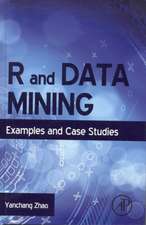Statistical Analysis of Climate Series: Analyzing, Plotting, Modeling, and Predicting with R
Autor Helmut Pruschaen Limba Engleză Paperback – 9 noi 2014
The methodical tools are taken from time series analysis, from periodogram and wavelet analysis, from correlation and principal component analysis, and from categorical data and event-time analysis.
The applied models are - among others - the ARIMA and GARCH model, and inhomogeneous Poisson processes.
Further, we deal with a number of special statistical topics, e.g. the problem of trend-, season- and autocorrelation-adjustment, and with simultaneous statistical inference.
Programs in R and data sets on climate series, provided at the author’s homepage, enable readers (statisticians, meteorologists, other natural scientists) to perform their own exercises and discover their own applications.
| Toate formatele și edițiile | Preț | Express |
|---|---|---|
| Paperback (1) | 606.94 lei 38-44 zile | |
| Springer Berlin, Heidelberg – 9 noi 2014 | 606.94 lei 38-44 zile | |
| Hardback (1) | 704.78 lei 38-44 zile | |
| Springer Berlin, Heidelberg – 30 oct 2012 | 704.78 lei 38-44 zile |
Preț: 606.94 lei
Preț vechi: 758.68 lei
-20% Nou
Puncte Express: 910
Preț estimativ în valută:
116.14€ • 126.55$ • 97.86£
116.14€ • 126.55$ • 97.86£
Carte tipărită la comandă
Livrare economică 19-25 aprilie
Preluare comenzi: 021 569.72.76
Specificații
ISBN-13: 9783642430879
ISBN-10: 3642430872
Pagini: 184
Ilustrații: VIII, 176 p.
Dimensiuni: 155 x 235 x 10 mm
Greutate: 2.88 kg
Ediția:2013
Editura: Springer Berlin, Heidelberg
Colecția Springer
Locul publicării:Berlin, Heidelberg, Germany
ISBN-10: 3642430872
Pagini: 184
Ilustrații: VIII, 176 p.
Dimensiuni: 155 x 235 x 10 mm
Greutate: 2.88 kg
Ediția:2013
Editura: Springer Berlin, Heidelberg
Colecția Springer
Locul publicării:Berlin, Heidelberg, Germany
Public țintă
ResearchCuprins
Climate series.- Trend and Season.- Correlation: From Yearly to Daily Data.- Model and Prediction: Yearly Data.- Model and Prediction: Monthly Data.- Analysis of Daily Data.- Spectral Analysis.- Complements.- Appendices: A: Excerpt from Climate Data Sets.- B: Some Aspects of Time Series.- C:Categorical Data Analysis- References.- Index.
Notă biografică
Helmut Pruscha, Professor for Mathematics, has served as Academic Director at the University of Munich’s Institute of Mathematics. Before doing so, he had worked for many years as a statistician at a Max-Planck-Institute for neurobiology. His research interests include topics concerning applied statistics and mathematical statistics, especially categorical time series and point processes. He has published several textbooks in German.
Textul de pe ultima copertă
The book presents the application of statistical methods to climatological data on temperature and precipitation. It provides specific techniques for treating series of yearly, monthly and daily records. The results’ potential relevance in the climate context is discussed.
The methodical tools are taken from time series analysis, from periodogram and wavelet analysis, from correlation and principal component analysis, and from categorical data and event-time analysis.
The applied models are - among others - the ARIMA and GARCH model, and inhomogeneous Poisson processes.
Further, we deal with a number of special statistical topics, e.g. the problem of trend-, season- and autocorrelation-adjustment, and with simultaneous statistical inference.
Programs in R and data sets on climate series, provided at the author’s homepage, enable readers (statisticians, meteorologists, other natural scientists) to perform their own exercises and discover their own applications.
The methodical tools are taken from time series analysis, from periodogram and wavelet analysis, from correlation and principal component analysis, and from categorical data and event-time analysis.
The applied models are - among others - the ARIMA and GARCH model, and inhomogeneous Poisson processes.
Further, we deal with a number of special statistical topics, e.g. the problem of trend-, season- and autocorrelation-adjustment, and with simultaneous statistical inference.
Programs in R and data sets on climate series, provided at the author’s homepage, enable readers (statisticians, meteorologists, other natural scientists) to perform their own exercises and discover their own applications.
Caracteristici
Within the context of the general climate discussion, the evaluation of climate series gains growing importance ? Provides application of statistical methods to climatological data Techniques for treating series records Applying among others ARIMA and GARCH model Programs in R and data sets on climate series are provided at the author's homepage Includes supplementary material: sn.pub/extras














